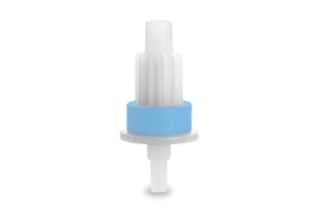
|
UNSPSC |
41115712 |
|
Brand |
Sep-Pak |
|
Product Type |
Solid Phase Extraction |
|
Units per Package |
50 pk |
|
Chemistry |
Accell Plus CM |
|
Format |
Plus Light Cartridge |
|
Ion Exchange Capacity |
370 µeq/gram |
|
Mass Spec Compatibility |
Yes |
|
Mode |
Ion-Exchange |
|
Particle Size |
37 - 55 µm |
|
Pore Size |
300 Å |
|
Sorbent Substrate |
Silica |
|
Sorbent Weight |
130 mg |
|
Water Wettable |
Yes |
|
pH Range Min |
2 pH |
|
pH Range Max |
8 pH |
|
Hold up volume |
0.4 mL |
Sep-Pak Accell Plus CM Plus Light Cartridge, 130 mg Sorbent per Cartridge, 37-55 µm, 50/pk
With a silica-based, hydrophilic weak cation-exchanger with a large pore size, the Sep-Pak Accell Plus CM Plus Light Cartridge is an excellent choice for anyone working with the extraction of cationic analytes in both aqueous and non-aqueous solutions. The large pore size used also makes these cartridges the ideal lab equipment for the isolation of molecules such as cationic proteins. Applications may also include extraction of steroids, pesticides, and herbicides, as well as phenolic compounds and peptide pool fractionations.
Sep-Pak Accell Plus CM Plus Light Cartridges feature a distinctive finned outer body and a reduced internal diameter, resulting in an interstitial volume that is about one-third that of the corresponding Plus-style cartridges. This design enables the elution of fractions in a minimal volume to improve recoveries and reduce solvent consumption. This is particularly beneficial in applications where samples may be limited or there is a concern about excessive dilution.
Each cartridge contains 130 mg of sorbent. These cartridges have a particle size of 37-55 µm and a pore size of 300å, as well as a carbon load of 5.5%. The pH range is 2 to 8, and the holdup volume is 0.4 mL. Each order includes 50 cartridges. If needed, a Long Needle Valve for Sep-Pak Device Vacuum Manifold, 20/pk can be purchased independently.
All Sep-Pak cartridges are manufactured in a Waters ISO 13485 and ISO 9002 registered facility, in compliance with cGMP guidelines for the U.S. Food and Drug Administration for Class 1 Medical devices.
What Is A Class 1 Medical Device?
The United States Food and Drug Administration (FDA) puts forward regulatory tiers of medical devices, known as classes, to ensure the health and safety of any items used in manufacturing food and drugs. Any medical device that poses a low to moderate risk to patient health and safety is considered Class 1 under these rules. Common examples may include bandages, stethoscopes, or hydrogen peroxide. Because of their proximity to pharmaceuticals and other consumer products, chromatography instrumentation is often subject to these same guidelines. All devices must therefore be properly registered through the FDA and a part of their public database.